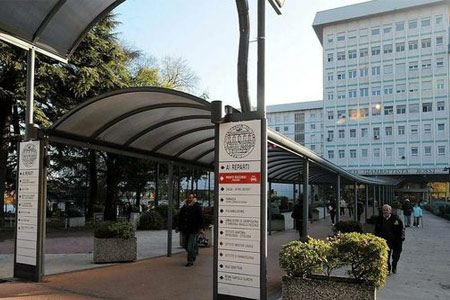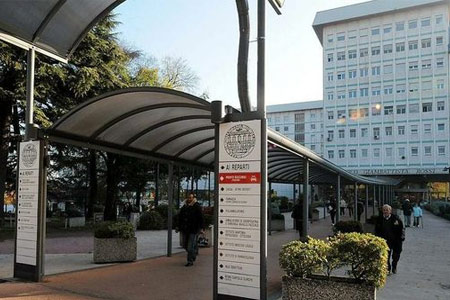- Autori:
-
Barzaghi, Federica; Minniti, Federica; Mauro, Margherita; Bortoli, Massimiliano De; Balter, Rita; Bonetti, Elisa; Zaccaron, Ada; Vitale, Virginia; Omrani, Maryam; Zoccolillo, Matteo; Brigida, Immacolata; Cicalese, Maria Pia; Degano, Massimo; Hershfield, Michael S; Aiuti, Alessandro; Bondarenko, Anastasiia V; Chinello, Matteo; Cesaro, Simone
- Titolo:
-
ALPS-Like Phenotype Caused by ADA2 Deficiency Rescued by Allogeneic Hematopoietic Stem Cell Transplantation
- Anno:
-
2018
- Tipologia prodotto:
-
Articolo in Rivista
- Tipologia ANVUR:
- Articolo su rivista
- Lingua:
-
Inglese
- Referee:
-
No
- Nome rivista:
- FRONTIERS IN IMMUNOLOGY
- ISSN Rivista:
- 1664-3224
- N° Volume:
-
9
- Intervallo pagine:
-
2767-2772
- Parole chiave:
-
ADA2; ADA2 deficiency; ALPS; CECR1; HSCT; autoimmunity; immunodeficiency; neutropenia
- Breve descrizione dei contenuti:
- Adenosine deaminase 2 (ADA2) deficiency is an auto-inflammatory disease due to mutations in cat eye syndrome chromosome region candidate 1 (CECR1) gene, currently named ADA2. The disease has a wide clinical spectrum encompassing early-onset vasculopathy (targeting skin, gut and central nervous system), recurrent fever, immunodeficiency and bone marrow dysfunction. Different therapeutic options have been proposed in literature, but only steroids and anti-cytokine monoclonal antibodies (such as tumor necrosis factor inhibitor) proved to be effective. If a suitable donor is available, hematopoietic stem cell transplantation (HSCT) could be curative. Here we describe a case of ADA2 deficiency in a 4-year-old Caucasian girl. The patient was initially classified as autoimmune neutropenia and then she evolved toward an autoimmune lymphoproliferative syndrome (ALPS)-like phenotype. The diagnosis of ALPS became uncertain due to atypical clinical features and normal FAS-induced apoptosis test. She was treated with G-CSF first and subsequently with immunosuppressive drugs without improvement. Only HSCT from a 9/10 HLA-matched unrelated donor, following myeloablative conditioning, completely solved the clinical signs related to ADA2 deficiency. Early diagnosis in cases presenting with hematological manifestations, rather than classical vasculopathy, allows the patients to promptly undergo HSCT and avoid more severe evolution. Finally, in similar cases highly suspicious for genetic disease, it is desirable to obtain molecular diagnosis before performing HSCT, since it can influence the transplant procedure. However, if HSCT has to be performed without delay for clinical indication, related donors should be excluded to avoid the risk of relapse or partial benefit due to a hereditary genetic defect.
- Id prodotto:
-
109265
- Handle IRIS:
-
11562/997266
- ultima modifica:
-
11 novembre 2022
- Citazione bibliografica:
-
Barzaghi, Federica; Minniti, Federica; Mauro, Margherita; Bortoli, Massimiliano De; Balter, Rita; Bonetti, Elisa; Zaccaron, Ada; Vitale, Virginia; Omrani, Maryam; Zoccolillo, Matteo; Brigida, Immacolata; Cicalese, Maria Pia; Degano, Massimo; Hershfield, Michael S; Aiuti, Alessandro; Bondarenko, Anastasiia V; Chinello, Matteo; Cesaro, Simone,
ALPS-Like Phenotype Caused by ADA2 Deficiency Rescued by Allogeneic Hematopoietic Stem Cell Transplantation
«FRONTIERS IN IMMUNOLOGY»
, vol.
9
,
2018
,
pp. 2767-2772
Consulta la scheda completa presente nel
repository istituzionale della Ricerca di Ateneo 








